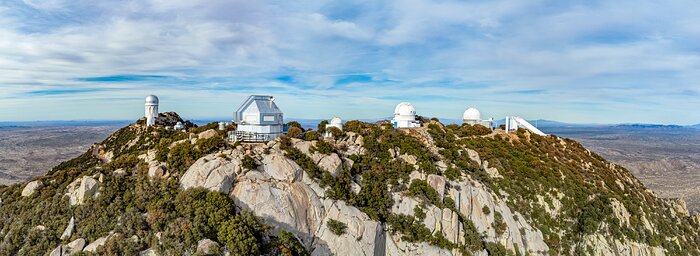Kitt Peak National Observatory at the Cutting Edge
Founded in 1958, Kitt Peak National Observatory (KPNO), a Program of NSF’s NOIRLab, is home to one of the largest collections of optical and radio telescopes in the world. The 24 optical and two radio telescopes sit on Kitt Peak, the highest point in the Quinlan Mountains in the Arizona-Sonoran Desert on the Tohono Oʼodham Nation, 88 kilometers (55 miles) southwest of Tucson, Arizona. Of those telescopes, 13 are captured in this image.
In its 60 years of operation KPNO has set records and achieved many firsts. The Nicholas U. Mayall 4-meter Telescope (left), named after KPNO’s second director, Nicholas Ulrich Mayall, was the second-largest telescope in the world at the time of its construction in 1973. In 1976 Mayall was used to discover methane ice on Pluto. The oldest telescope at KPNO, the UArizona 0.9-meter Spacewatch Telescope, seen slightly below the Mayall telescope in this photo, houses the first large telescope mirror successfully cast in the United States. The Spacewatch telescope was also the first used to search for near-Earth asteroids. The McMath–Pierce Solar Telescope (right) was for many decades the largest solar telescope in the world and the largest unobstructed reflector mirror, i.e., there was no secondary mirror in the path of incoming light. It was decommissioned in 2017, and is now being converted to the NOIRLab Windows on the Universe Center for Astronomy Outreach.
This photo was taken as part of the recent NOIRLab 2022 Photo Expedition to all the NOIRLab sites.
Credit:KPNO/NOIRLab/NSF/AURA/T. Matsopoulos
About the Image
| Id: | iotw2345a |
| Type: | Photographic |
| Release date: | Nov. 8, 2023, noon |
| Size: | 7592 x 2778 px |
About the Object
| Name: | McMath-Pierce Solar Telescope, Nicholas U. Mayall 4-meter Telescope, UArizona 0.9-meter Spacewatch Telescope |
| Category: | Kitt Peak National Observatory |
